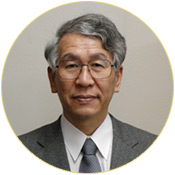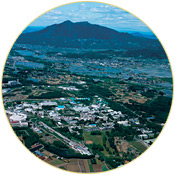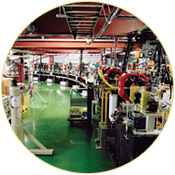 |
| Illustrations: Sandbox Studio |
| Based on Hiroshige’s woodcut series of Mt Fuji. |
KEKs ambitious future
by David Harris
with additional reporting by ILC NewsLine staff
Japan's high-energy physics laboratory KEK is undergoing a transition as it expands its science program with upgraded and new facilities.
A 45-minute train ride north of Tokyo, Mt Tsukuba stands over a conglomerate of semi-rural agricultural fields dotted with a mix of hamlets and high- tech industry. In the middle of this diverse landscape is one of the world's leading particle physics laboratories, Japan's High Energy Accelerator Research Organization (KEK).
KEK is the scientific home for about 700 staff members. In addition, 4000 visitors per year from within Japan and from overseas use the high-energy physics and X-ray light source facilities. A highly collaborative institution, KEK is currently increasing its ties within Japan and abroad to other laboratories, universities, and industry partners as it expands its research efforts. KEK is in the process of building a new proton accelerator facility at its Tokai campus, an hour's drive northeast of its Tsukuba campus; is upgrading some of its existing facilities; and plans a suite of far-reaching experiments for the future.
A turning point
Growing out of nuclear physics research cyclotrons and synchrotrons in the 1950s and 1960s, KEK began its life as Japan's national laboratory for high-energy physics in 1971. During its history, it has built electron, positron, and proton accelerators, used for research ranging from nuclear and particle physics to materials and life sciences.
Today KEK is perhaps best known for its particle physics research with the KEKB accelerator and Belle experiment, and its involvement in neutrino research in collaboration with the Kamiokande experiments by the Institute of Cosmic Ray Research of the University of Tokyo.
However, KEK sits at a turning point with ambitious future plans to expand its accelerator-based research and continue as one of the world's leading particle physics research facilities. Its current projects include current particle physics experiments, R&D for the International Linear Collider, next-generation neutrino experiments, and a next-generation light source for materials and life-science research.
Two years ago, KEK changed from being a national laboratory to the independent Inter-University Research Institute Corporation for high-energy accelerator research. New director-general Atsuto Suzuki says, "We are taking advantage of our new status being less restricted by the governmental regulations. These improvements will enhance research activities in the long run."
He continues, "As has [previously] been, the mission of KEK is to strongly push research on particle/nuclear physics and on materials structure science forward, and to promote the activities of university researchers utilizing the KEK facility as the inter-university research organization."
 |
| Atsuto Suzuki became director-general of KEK on April 1, 2006. |
| Photo: KEK |
KEK's new director-general
Following three years of leadership by Yoji Totsuka, who stepped down due to ill health, Suzuki, Director of the Research Center for Neutrino Science and Vice President of Tohoku University, began his three-year term as director-general of KEK on April 1, 2006.
Suzuki received the 2005 Medal of Honor with Purple Ribbon from the Japanese government, a medal awarded to individuals who have made outstanding accomplishments in artistic and academic fields. The Japan Academy awarded its 2005 Prize to Suzuki "for his achievement for the first observation of geologically produced neutrinos by radiogenic material decays deep inside the earth."
Beginning his work at KEK, Suzuki appreciates both the excitement and challenges of such a diverse laboratory as KEK as it moves into a new era of particle physics discoveries. He says, "To lead this unique laboratory during the critical years ahead is extremely challenging. In realizing [its programs], it is essential to make international collaborations from both experimental and financial points of view. We would like to open these discussions to the high-energy physics community worldwide."
B-factory successes
The KEKB accelerator plus Belle detector comprise a B-factory, similar in many ways to the PEP-II/BaBar combination at Stanford Linear Accelerator Center. These two collaborations have long been engaged in friendly competition, often leapfrogging each others' records in measures such as machine luminosity and number of papers published by the experimental collaborations. Driven to excel by competition, both groups have advanced physicists' understanding of many of the details of the Standard Model of particle physics, and, in particular, the differences between matter particles and their antimatter counterparts.
In its current form, the KEKB accelerator will reach a new benchmark for total integrated luminosity (effectively, the total number of collision events recorded) of 1000 inverse femtobarns (a measure for luminosity) by summer 2008, and has exceeded all design expectations. An upgrade to the KEKB accelerator, coming as early as this summer, could bring that milestone forward by up to one year. During its annual shutdown, KEK physicists will install and test "crab cavities." These devices rotate bunches of electrons and positrons circulating in the collider so that they have greater overlap when two of them meet at the collision point inside the Belle detector. That greater overlap would mean more collisions for the detector to observe and faster accumulation of data for analysis.
Proud of its success, Suzuki says, "The electron-positron colliding-beam accelerator (KEKB) in Tsukuba Campus has been fully utilized taking advantage of the world's highest beam intensity for this type. We expect more results on the differences between particles and their antiparticles."
With KEKB running so well, the KEK Accelerator Review Committee recommended in March this year that KEK conduct the studies to design a major upgrade that would increase the luminosity of the machine by a factor of ten or more. The Committee sees the physics potential of a SuperKEKB accelerator as particularly promising in light of the number of high-energy physics facilities that are due to finish operating in the next few years (HERA at DESY in Germany, PEP-II at Stanford Linear Accelerator Center, and the Tevatron at Fermilab).
|
The smaller, 3-GeV proton synchrotron will provide beams of protons to create neutrons and muons (which are heavier cousins of electrons). The neutrons will be part of a neutron spallation source (NSS), similar to the recently opened Oak Ridge National Laboratory Spallation Neutron Source (SNS). NSS will have 23 neutron beamlines and will serve about 3000 users. Approximately 15 experimental devices have been tentatively planned for use in the beamlines, many of which will be used for advanced materials development.
 |
| KEK campusAerial view of KEK with Mt. Tsukuba in the background. |
| Photo: KEK |
The remainder of the protons from the 3-GeV machine will be transferred to the 50-GeV machine. One use of the higher-energy protons will be to produce muon neutrinos that are sent 295 km through the earth to the existing Super-Kamiokande detector on the west coast of Japan's main island. Passing by different types of detector at 280m, and potentially 2 km, the T2K (Tokai to Kamioka) experiment will look for muon neutrinos turning into both tau neutrinos and electron neutrinos, the latter being an important measurement eagerly awaited by neutrino physicists.
The 50-GeV protons will also be used in a hadron factory, which will have about 600 users, one third of whom will come from Japan. The hadron factory will explore fundamental properties of nuclei and elementary particles containing quarks.
Although J-PARC is ostensibly a collaboration between Japanese institutions, its director Shoji Nagamiya says, "We would like to welcome US participation at J-PARC."
Toward an International Linear Collider
Soon after taking his position, Suzuki said, "We start various R&D efforts for future research projects, such as the International Linear Collider project…to stay in a leading role in worldwide researches."
This sentiment was expressed strongly by a Japanese ad hoc committee on the Linear Collider Project. Representing leading scientific organizations and industries in Japan, the members of the committee issued several recommendations, including a statement that the "KEK Director General should lead the studies on a suitable international organizational structure for first promoting, then later executing, the ILC Project, with particular attention to its timely realization and later to hosting of the project in Japan."
 |
| KEKs Advanced Test Facility is the forefront of low-emittance and high intensity beam steering technology. These technologies are essential for the proposed ILC. Seen in the photo is the northwest part of the ATF damping ring, with the arc section of the ring and the beam extraction line in the background. |
| Photo: KEK |
KEK research and development for the ILC has two major components at this time: the construction of high-gradient superconducting cavities, needed for accelerating the electrons and positrons, and a test-beam facility at which various components of the ILC beam-handling system can be developed.
In initial testing, KEK scientists have had success in building test cavities with a new design developed by an international collaboration. In some of the new cavities the amount of acceleration potential, called gradient and expressed in megavolts per meter, has surpassed the 31.5 MV/m gradient required in the ILC's Baseline Configuration Document. Individual cavities have achieved gradients of over 50 MV/m. However, this research and development is still at an early stage and no lab that is testing cavities has yet developed a design suitable for mass production that reliably achieves the needed specifications.
The Advanced Test Facility (ATF) at KEK currently has the lowest emittance (most tightly focused) electron beam in the world for studying the myriad systems that are needed to guide, direct, and shape the electron and positron beams as they race toward collision. Other beam test facilities at DESY and Fermilab offer complementary features useful for ILC development. Much of the work being done at the ATF involves international collaboration, with US, Asian, and European particle physicists regularly visiting and using the facility. A significant upgrade (ATF2) is planned to commence operation in 2008. The ATF2 facility has primary goals of achieving a small focused beam size and precise control of the beam position.
Head of the KEK Linear Collider Office Kaoru Yokoya says, "It is my dream to bring the ILC to Japan. Even if it would turn out not to be the case, I still want to make sure that the Japanese presence and contributions are visible to the world."
A next generation X-ray light source
KEK has been operating its Photon Factory synchrotron since 1983 and the Japan Synchrotron Radiation Research Institute has been operating the SPring-8 synchrotron since 1997. But there is increasing demand for new types of light sources in Japan, and KEK is looking to a next-generation light source.
While the new light sources being built at SLAC and DESY are X-ray free electron lasers (XFELs), KEK and some laboratories in the United States, England, Germany, and Russia are focusing on Energy Recovery Linacs (ERLs). While KEK has not made the final decision to build an ERL, it is working on the research and development for such a machine, and scientists hope to build a test machine followed by the full ERL construction.
An ERL has a racetrack shape with two parallel straight sections, one of which contains the accelerating cavities that bring the electron bunches up to the desired energy. The ends of the straight sections are joined by arcs from which X-ray beamlines fan out. KEK's ERL would have a 407-meter linac to boost electrons to between 2.5 and 5.0 GeV, and it would be tunable in energy and other parameters to satisfy the needs of experimenters.
Compared with a circular storage ring synchrotron, an ERL has better beam quality (shorter bunches, less energy spread, smaller beam size). Compared with XFELs, an ERL has lower peak brightness but higher average brightness, and the ERL has a more stable intensity of light. Each type of light source has advantages and disadvantages depending on the types of experiments to be conducted.
Strengthening Asian accelerator sciences
The progress and plans of KEK represent a strong vitality in the Japanese particle physics research effort, which is working with the regional and international community to further the field's scientific achievements.
Chair of the Asian Committee on Future Accelerators Shin-ichi Kurokawa says, "It is important to strengthen the activities of accelerator sciences in the Asian region. We would like to establish strong ties between Asian countries in every field of the accelerator sciences, covering high-energy physics, accelerator physics, synchrotron-radiation, and spallation neutron sciences."
Although KEK is just one Japanese lab of many involved in this effort, its future looks assured among the worldwide leaders in accelerator sciences.
Click here to download the pdf version of this article.






